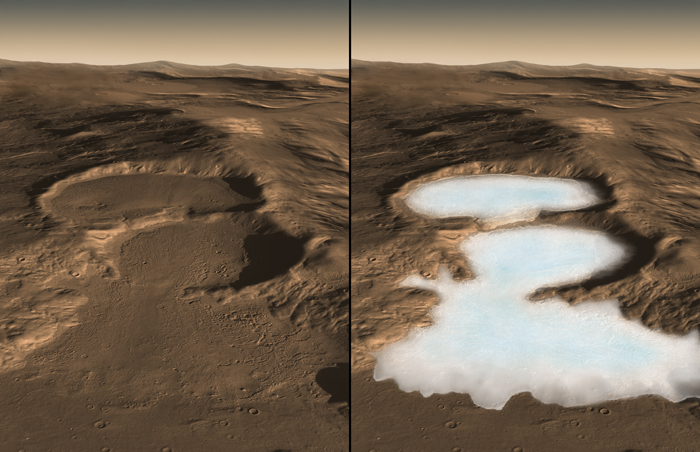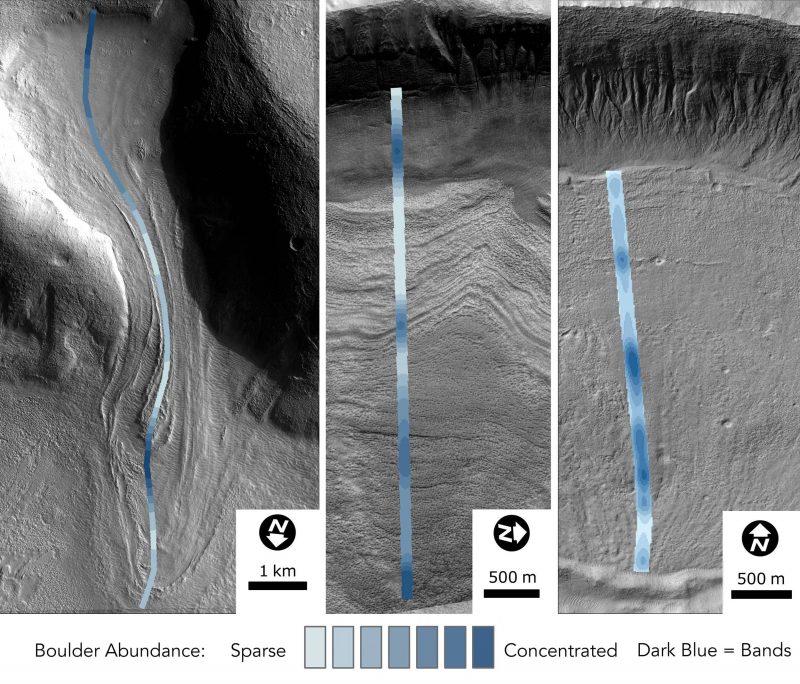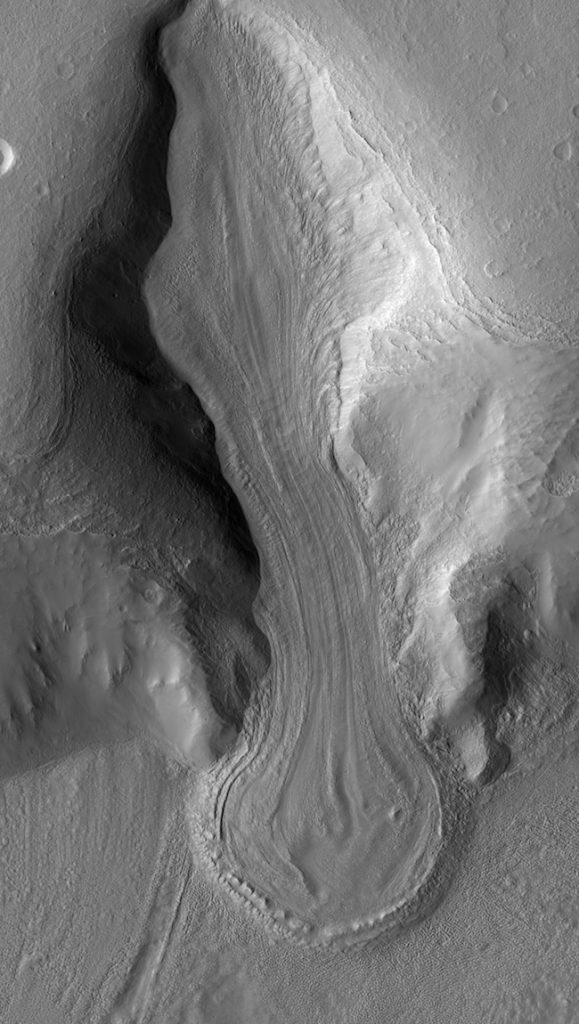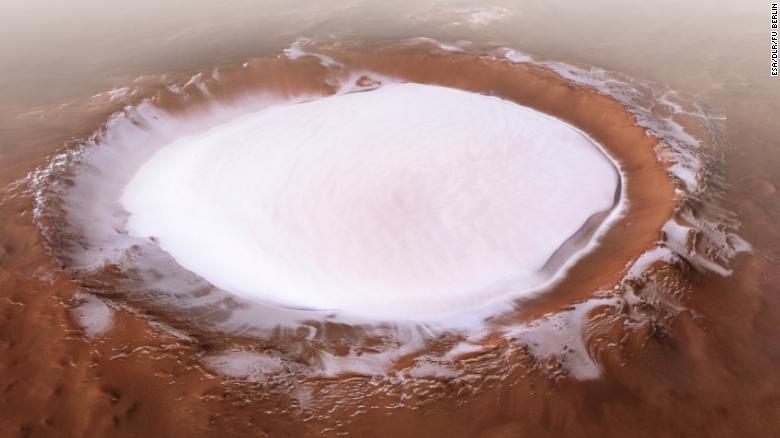
Just as on Earth, glaciers have flowed across the surface of Mars in the distant past. But while Earth’s glaciers have mostly receded (and are still shrinking), Mars’ glaciers are frozen in place and covered by rocky debris. Scientists haven’t been sure if there was one huge Ice Age on Mars, or multiple ice ages spread out over millions of years. Now, a new study announced by researchers at Colgate University in New York state is helping to answer those questions. It suggests that Mars has undergone anywhere from half a dozen to 20 ice ages in the past several hundred million years.
The peer-reviewed findings were published in the journal Proceedings of the National Academies of Science (PNAS) on January 26, 2021.
EarthSky 2021 lunar calendars still available! Order now. Going fast!
The researchers, led by planetary geologist Joe Levy at Colgate University, decided to analyze the glaciers in more detail by examining the rocks sitting on top of them. That rocky debris has been covering the frozen ice for over 300 million years. Levy stated:
All the rocks and sand carried on that ice have remained on the surface. It’s like putting the ice in a cooler under all those sediments.
Levy and his colleagues wanted to study the sizes, distribution and number of rocks on top of the glaciers. If there was a progression of larger to smaller rocks going downhill, due to erosion, that would point toward one long ice age event instead of multiple ones.

The researchers used images of 45 glaciers from NASA’s Mars Reconnaissance Orbiter (MRO) spacecraft for their study. The cameras on MRO are powerful, with a resolution down to 25 centimeters (10 inches) per pixel. As Levy noted:
You can see things the size of a dinner table.
Over two summers, 10 Colgate students assisted Levy by counting and measuring larger rocks seen in the images, about 60,000 altogether. Levy said:
We did a kind of virtual field work, walking up and down these glaciers and mapping the boulders.
Levy had expected to see the boulders distributed by size, but that’s not what the images showed. Instead, the rocks were scattered randomly, leading to an interesting conclusion, Levy said:
In fact, the boulders were telling us a different story. It wasn’t their size that mattered; it was how they were grouped or clustered.

The team realized that the rocks had been travelling along inside the glaciers, and therefore not eroding as had been expected. They were also grouped in bands across the glaciers, which indicated distinct separate flows over millions of years – multiple ice ages – instead of just one major ice age event.
That’s when the researchers concluded that Mars has experienced somewhere between six and 20 separate ice ages during the past 300-800 million years. Levy elaborated, saying:
This paper is the first geological evidence of what Martian orbit and obliquity might have been doing for hundreds of millions of years. These glaciers are little time capsules, capturing snapshots of what was blowing around in the Martian atmosphere. Now we know that we have access to hundreds of millions of years of Martian history without having to drill down deep through the crust; we can just take a hike along the surface.
As outlined in the paper:
Significant debate exists whether the global population of Martian debris-covered glacier deposits formed continuously over the past 300 to 800 Ma, or whether they formed during punctuated episodes of ice accumulation during obliquity maxima (lasting 10-100 ka). We show that, like ancient debris-covered glaciers on Earth, boulder banding on Martian glacial deposits indicates multiple episodes of ice accumulation and advance. In our analysis, glacial periods are followed by ice removal from the glacier accumulation zone, forming debris bands. We report a median of five to six glacial/interglacial transitions recorded on Martian debris-covered glaciers, suggesting the cadence of glaciation on Mars is set by orbital forcing over tens to hundreds of Ma, not individual 120 ka obliquity cycles.

The results have significant implications for understanding Mars’ history. Ice ages occur during shifts in the tilt of a planet’s axis, called obliquity. This has direct effects on a planet’s climate and habitability. Earth’s axial tilt is also why we have seasons.
Scientists would like to know what kinds of rocks and gases are still trapped inside these glaciers, and they would be a great place to search for fossils or other biomarkers of ancient microbes. As Levy said:
If there are any biomarkers blowing around, those are going to be trapped in the ice too.
The glaciers could provide clues as to whether Mars was warm and wet early in its history before turning cold and dry, or whether Mars always had a colder climate. This has been a matter of much debate, since there is ample evidence that the planet once had lakes, rivers and maybe even an ocean, but lesser evidence for a climate that was warm enough, with a thick enough atmosphere, for widespread liquid water, a sort of planetary paradox. Levy said:
There’s a lot of work to be done figuring out the details of Martian climate history, including when and where it was warm enough and wet enough for there to be brines and liquid water.

Another new study from Rice University suggests that Mars was somewhere between the two scenarios of warm/wet and cold/dry, with a climate similar to that in Iceland, a frigid climate, but not too cold for liquid water. Michael Thorpe at Rice referenced the Curiosity rover’s landing site, Gale Crater. He said:
Sedimentary rocks in Gale Crater instead detail a climate that likely falls in between these two scenarios. The ancient climate was likely frigid but also appears to have supported liquid water in lakes for extended periods of time.
Iceland is one of the closest analogs to ancient Mars, with basaltic terrain and temperatures usually less than 38 degrees Fahrenheit (3 degrees Celsius). The composition of sand and mud in Iceland is also the closest match to Mars based on analysis via the standard chemical index of alteration (CIA), which is used to infer past climate from chemical and physical weathering of a sample.
Bottom line: Scientists have determined that Mars has undergone anywhere from half a dozen to 20 ice ages in the past several hundred million years.











